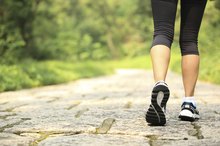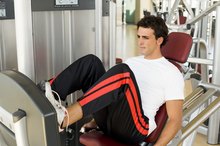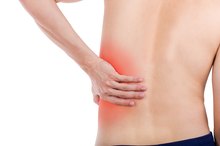Back Pain While Walking
Many situations can lead to back pain, including obesity, poor posture, improper body mechanics, arthritis, disc injuries and nerve entrapment. Some back pain is worse when sitting, while others feel more pain when standing, twisting and bending. Some patients also experience a worsening of back pain while walking. The first step in managing back pain is identifying the cause so that the right treatment can be started.
Considerations
No matter the cause, back pain can make walking painful. Changes to the discs in the spine from normal wear and tear can lead to degenerative forms of arthritis. Muscular tightness and disc injuries also can place pressure on the sciatic nerve, which can cause back pain while walking. It is important to have the cause of back pain properly evaluated, as a disc injury calls for a different treatment approach than a muscular imbalance. Walking might be contraindicated until the underlying problem is resolved, or a program of strengthening and stretching can help to alleviate symptoms, says the National Institute of Neurological Disorders and Stroke.
- No matter the cause, back pain can make walking painful.
- It is important to have the cause of back pain properly evaluated, as a disc injury calls for a different treatment approach than a muscular imbalance.
Benefits
How to Run After a Herniated Disc
Learn More
Unless advised by a doctor to avoid exercise, walking and other forms of exercise are often recommended to help ease symptoms. When the back, abdominal, hip and leg muscles are strong and flexible, less pressure is placed on the back.
In addition, weight loss might be part of the overall treatment plan because being overweight places excessive strain on the back, warns the National Institute of Arthritis and Musculoskeletal and Skin Diseases. Walking for 30 to 45 minutes every day is a good way to shed extra pounds. Work with a physician or physical therapist if just starting out to learn how to walk correctly and in a way that will not make back pain worse.
- Unless advised by a doctor to avoid exercise, walking and other forms of exercise are often recommended to help ease symptoms.
- Work with a physician or physical therapist if just starting out to learn how to walk correctly and in a way that will not make back pain worse.
Strengthen Supporting Muscles
Exercising the muscles that support the back for 15 minutes three times a week can help to reduce pain, states the National Institutes of Health. When first starting to exercise and walk, expect some back soreness, but exercise should never make the back pain worse. Start slowly and increase the intensity gradually.
Exercises such as the bridge pose, arm and leg lifts on all fours, crunches, waist bends, back extensions, squats and lunges can help to make the back, abdominals and legs stronger. As the muscles that support the back build strength, walking should become more comfortable. Working with a therapist or trainer is the best way to get started because exercising the wrong way can make back pain worse.
- Exercising the muscles that support the back for 15 minutes three times a week can help to reduce pain, states the National Institutes of Health.
- When first starting to exercise and walk, expect some back soreness, but exercise should never make the back pain worse.
Stretching
Physical Therapy Procedures for Pinched Nerves in Lumbar Vertebrae
Learn More
It also is important to keep muscles flexible, since tight muscles can pull on the lower back and cause pain. According to the Mayo Clinic, the right stretching program can help to both ease back pain and prevent it from reoccurring. The best time to stretch is after walking, when muscles are warm.
Helpful stretches include hugging the knees to the chest, dropping both knees to the side in a spinal twist, and lying on the back and extending one leg at a time straight up. Stretches always should be done slowly and held for at least 30 seconds, without bouncing.
- It also is important to keep muscles flexible, since tight muscles can pull on the lower back and cause pain.
- According to the Mayo Clinic, the right stretching program can help to both ease back pain and prevent it from reoccurring.
Modalities
When back pain flares up and makes walking challenging, the Arthritis Foundation suggests using either heat or cold. Applying heat before walking or taking a hot shower can help to relax the muscles and make them more receptive to exercise. After walking, apply ice to help calm pain and inflammation. When back pain is severe, try walking in the water to help take pressure off the back and relax the muscles.
Incorporating tai chi or yoga exercises between walking can help keep muscles loose, and both teach relaxation techniques to manage pain. Some patients also find relief by getting massage or acupuncture treatments.
Wear supportive shoes designed for walking and use good posture and body mechanics. Back braces might help, but they also can make the muscle weaker if worn too much, so talk to a doctor or therapist before using a brace. Using a cane, walking stick or poles can be helpful as they can take pressure off the back and legs.
- When back pain flares up and makes walking challenging, the Arthritis Foundation suggests using either heat or cold.
- Using a cane, walking stick or poles can be helpful as they can take pressure off the back and legs.
Related Articles
References
- National Institute of Arthritis and Musculoskeletal and Skin Diseases: What is Back Pain
- MayoClinic.com: Back Pain Treatments and Drugs
- Steffens D, Maher CG, Pereira LSM, et al. Prevention of low back pain. A systematic review and meta-analysis. JAMA Intern Med. 2016;176(2):199-208. doi:10.1001/jamainternmed.2015.7431
- Koes BW, van Tulder M, Lin CW, Macedo LG, McAuley J, Maher C. An updated overview of clinical guidelines for the management of non-specific low back pain in primary care. Eur Spine J. 2010;19(12):2075-2094. doi:10.1007/s00586-010-1502-y
- American Academy of Orthopaedic Surgeons. Low-back surgery exercise guide. Updated January 2017.
- Shnayderman I, Katz-Leurer M. An aerobic walking programme versus muscle strengthening programme for chronic low back pain: A randomized controlled trial. Clin Rehabil. 2013;27(3):207-14. doi:10.1177/0269215512453353
- Kim H, Min TJ, Kang SH, Kim DK, Seo KM, Lee SY. Association between walking and low back pain in the Korean population: A cross-sectional study. Ann Rehabil Med. 2017;41(5):786-792. doi:10.5535/arm.2017.41.5.786
Writer Bio
I hold a Master's degree in exercise physiology/health promotion. I am a certified fitness specialist through the American College of Spots Medicine and an IYT certified yoga teacher. I have over 25 years experience teaching classes to both general public and those with chronic illness. The above allows me to write directly to the reader based on personal experiences.









